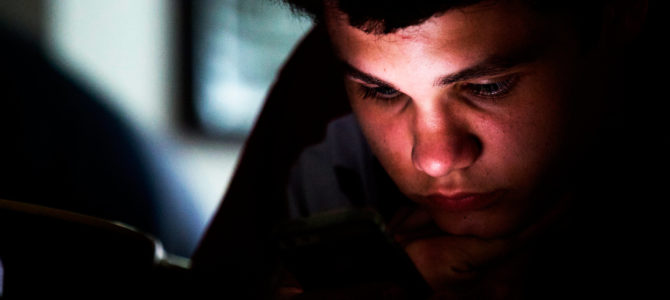
“Lol” [laugh out loud] and other common texting lingo may be a contingent means for people to express laughter or amusement—but there is something else going on here; something I worry largely goes unaddressed in the repetitive online space.
Screen-based communication—which has accelerated due to the coronavirus to become the primary mode for communication at all for many—has morphed into a predictable way for people to mitigate interpersonal risk, uninhibited. It permits them to hide behind the screen in total control of their persona and appearance.
“Lol” has cemented itself as an engine of this, as peers look to appease each other endlessly, dishing out empathy points.
Speaking in a 2013 TED talk titled “Txtng is killing language. JK!!!” linguist and Columbia University professor John McWhorter discussed how people feel the need to swiftly ease relations with peers, often doing so through laughing abbreviations such as “lol.” McWhorter presented an example of two women, Susan and Julie, having a conversation.
Susan and Julie use “lol” in each message. However, he points out how nothing is particularly comedic about the conversation. It is simply about how Julie’s email is slow and how Susan has a 10-page paper due for school. It’s a conversation that would be mundane in-person, and an oddity should it not be.
“‘Lol’ is being used in a very particular way,” McWhorter said. “It’s a marker of empathy. It’s a marker of accommodation. We linguists call things like that ‘pragmatic particles.’ Any spoken language that’s used by real people has them. …A pragmatic particle, that’s what ‘lol’ has gradually become.”
People are not only engaged in an incalculable bid to validate each other, as McWhorter describes, but they are also worried about sounding too sober, too disagreeable, too unhip. Technology drives the song-and-dance phenomenon.
Tech Barriers
Consider this skit from the comedy series “Key & Peele” featuring Keegan-Michael Key and Jordan Peele, which went off the air in 2015, depicting two men who completely misread the other’s motives over text. It results in confusion and anger in one of them.
A more uptight man messages his stoner friend who is playing video games, “I’ve been trying to reach out to you all day, are we on for tonight?” In response, the friend says, “Sorry dude, missed your texts, I assumed we’d meet at the bar, whatever, I don’t care.”
While the friend who said “whatever” is sincerely being nonchalant and is just lazy, the more A-type friend takes this as a diss. After a series of messages, the serious man angrily says, “You are f-cking priceless,” to which the other endearingly says, “You’re the one who’s f-cking priceless,” not comprehending the disconnect in meaning.
In the end, the serious man shows up at the bar with a spiked bat and the other thinks it’s a joke.
This “Key & Peele” sketch is a perfect illustration of how technology obstructs our ability to effectively ascertain another’s tone, motives, and thought processes. Most understand this predicament, so they use laughing abbreviations like “lol” to communicate a sense of serenity. It’s like a way to pat someone on the back, just with a keyboard.
“Lol” quickly developed into not only a way to show empathy and even one’s sense of humor and supposed hip-nature, but also a tool to display a cool, calm, and collected digital demeanor. McWhorter, who frequently discusses the psychology behind “lol,” built on his ideas in this video recorded at the 2018 Aspen Ideas Festival. He juxtaposed the prior usage and denotation of “lol” with its current one.
“In very early texts, if someone used ‘lol’ or ‘haha’ they meant that something was genuinely funny. It meant ‘laugh out loud.'” the linguist said. “And gradually, that evolved into meaning not that you were laughing out loud but a kind of subset of what laughter is about, which is softening, which is easing circumstances between people—such that ‘lol’ came to mean ‘don’t sweat it, I’m not being severe.'”
“What it’s really doing is exactly what meaningless little giggles mean when you’re having regular conversations with people,” he added.
The linguist makes an important point here, but laughter abbreviations inevitably differ from in-person laughing in their goal of granting social credit; the sender also gains points by acting agreeable, even if nothing warrants acting like there is anything comedic about the exchange.
People do, of course, laugh in person to ease tensions. But in order to adequately do this, one must actually flex their mouth muscles and appear amused. Instead, technology permits us to hide behind a screen and not crack a smile. Thanks to screens, we can be robotic, if we so choose, and embrace it as our primary mode of communication with others.
The difference is that there is no crowd in front of a screen, no audience, no listeners to appease behind the screen. It’s performative and lonely.
Compensation for Lack Of Humanity
A Reddit thread from four years ago pointed out how “lol” has become distorted from its original denotation; how it no longer is what it used to be—or ever could be given its reliance on the internet to function. In other words, it was doomed from the start.
“Actually a lot of the time I use it to mean ‘that doesn’t amuse me at all but I can tell it was supposed to so if I don’t say lol the person I’m texting may be offended'” wrote a user who has since deleted his account.
“We developed tolerance to LOLs. Now we must resort to stronger stuff like LMAO and ROFL to get our heads high on laughter,” described another user named Snaggel, remarking on how only so much laughter can go around via technology, and how people now resort to capitalization to get the supposed laughing emotion across.
“Lol is more like you think it ain’t funny but you want someone to feel better about how unfunny they are,” chimed in another user.
What McWhorter and the Redditors intend to characterize was underscored in a 2018 University of York undergraduate study titled “‘Lol’: Not just a laughing matter.” In analyzing tweets from 2017 and 2018, the researcher found that “lol” is typically used on social media “to compensate for the lack of non-verbal cues — such as laughter, tone and facial expression” that are inherent to in-person interactions.
Evidently, the meaning has become obscured, inorganic, built on a transactional experience. But given the barrier that is a lack of human presence, how could it be any other way?
Too Online™ Culture
The “lol” phenomenon is another example of how technology—with all its overwhelming effectiveness and ability to improve human lives—does not and cannot truly replace human interactions. One need only look at the last two years to understand this reality.
As many on the left pushed for lockdowns and “social distancing,” and still do, the wholesale migration to Zoom accelerated social decay. No honest person would say his social interactions were improved by such tyrannical restrictions.
“Lol” is a product of a culture far Too Online™. Americans cannot be content forever solitarily participating in a performative “laughter” culture, even if such abbreviations are inevitable on digital platforms. And “Lol” may be doomed meaning-wise, but laughing out loud surely is not.
Because nothing is more real than real.
Still, it is probably far too naive, too idealistic, to think we will all unplug tomorrow from our preferred Matrix—and resume life together in the physical world only: the only real world, that is. Until then, we will all “lol” away at nothing in particular.
Lol.









